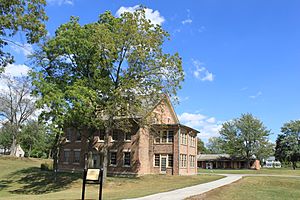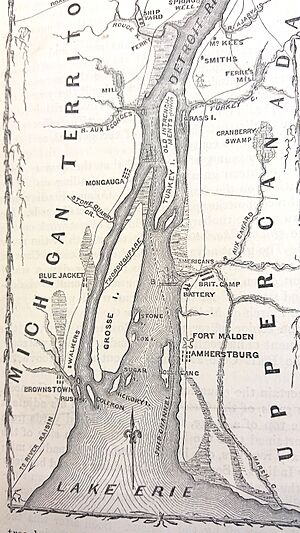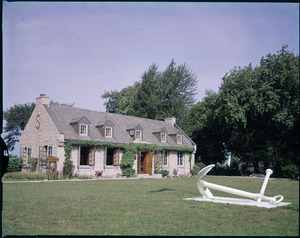Fort Malden facts for kids

The museum, standing in front of the restored soldiers' barracks
|
|
| Established | 1796 |
|---|---|
| Location | Amherstburg, Ontario Canada. |
| Type | Military Fortification |
| Designated: | 1921 |
Fort Malden, also known as Fort Amherstburg, is a historic fort in Amherstburg, Ontario, Canada. It was built in 1795 by Great Britain to protect British North America from possible attacks by the Americans.
This fort is famous for its role in the War of 1812. Important leaders like Sir Isaac Brock and Tecumseh met here to plan the Siege of Detroit. Fort Malden was a key British base during the war. Today, it is a National Historic Site of Canada. The fort also helped protect Upper Canada's border with Detroit during the Upper Canada Rebellion.
Beyond its military past, Fort Malden has a rich history. It was once a place for retired soldiers to live, called the British Pensioner Scheme. Later, in 1859, it became a hospital for people with mental health challenges. After the hospital closed, the land was privately owned for a while. Local residents worked hard for many years to save the fort. It was officially recognized as a historic site in 1921. The buildings you see today were brought together in 1946.
Today, Parks Canada manages Fort Malden, and it is open to the public. Visitors can explore different parts of the fort's history. For example, you can see an old brick barracks from 1819, restored to look like it did in 1839. You can also see the Hough House, which shows the fort's time as a hospital, a lumber mill, and a private home.
Contents
Fort Malden's Story
Building the Fort (Before 1795)
In 1784, Governor Sir Frederick Haldimand decided that the land across from Bois Blanc Island (now Amherstburg) was a perfect spot for a military fort. Before this, local Indigenous people had already used this area as a strategic defense spot.
Early Years (1795–1812)
After a treaty in 1795, British soldiers moved from Fort Detroit to the new fort. In 1797, the fort was officially named Fort Amherstburg after General Lord Amherst. However, because it was in the area called Malden, people living nearby started calling it Fort Malden. This name has stuck ever since.
The War of 1812 (1812–1814)
Fort Malden's role in the War of 1812 began on July 2, 1812. British forces at Amherstburg captured an American ship called the Cuyahoga. The United States had declared war on Great Britain on June 18, but the American General William Hull didn't know yet.
On July 12, General Hull's American forces crossed the Detroit River and took the town of Sandwich (now Windsor, Ontario). Hull used the Francois Baby House as his headquarters. He told the people of Upper Canada that his army came to protect them, not to harm them. He warned against fighting alongside Indigenous warriors, saying it would lead to harsh consequences.
On July 16, British soldiers from Fort Malden fought Hull's troops at the River Canard. Two British soldiers died, marking the first deaths of the War of 1812.
Major General Sir Isaac Brock took command of Fort Malden on August 13, 1812. Days later, he led British troops across the Detroit River. On August 16, with help from Chief Tecumseh and his Indigenous warriors, Brock and Tecumseh marched on Fort Detroit. General Hull was afraid of a large attack by Indigenous warriors. Brock and Tecumseh used this fear, making Hull believe they had 5,000 warriors. Because of this, Fort Detroit surrendered without a fight. This victory, known as the Siege of Detroit, was very important for getting Indigenous support for the British.
Later in the war, the British decided to focus on protecting other parts of Canada. In September 1813, General Henry Proctor had to leave Fort Malden. He burned the fort and retreated with his troops. American forces chased them, leading to the Battle of the Thames.
American Control (1813–1815)
After General Proctor burned Fort Malden, American forces took over the area. They used the land to launch raids into nearby areas. The Americans also started rebuilding Fort Malden. The war ended with the Treaty of Ghent in February 1815. The land, including Fort Malden, was returned to the British. The American army left Fort Malden on July 1, 1815.
Upper Canada Rebellion (1837–1838)
After some time, Fort Malden was used again to house soldiers and stop the Upper Canada Rebellion. The fort helped defend Upper Canada from American groups called "Hunters' Lodges." These groups often raided the border along the Detroit River. Because of this new threat, Fort Malden was improved with new buildings and repaired defenses. Several regiments, including the Royal Artillery, were stationed there.
On January 9, 1838, American "Hunter" Patriots tried to raid Amherstburg by crossing the Detroit River on a ship called the Anne. All the soldiers, local militia, and Indigenous warriors successfully defended the town. They captured twenty American prisoners. After the rebellion ended, fewer soldiers were needed.
The Pensioner Scheme (1839–1858)
When soldiers started leaving the fort, the people of Amherstburg worried about their safety. So, the 34th (Cumberland) Regiment of Foot was stationed at Fort Malden. From 1839 to 1840, the fort was further developed with more barracks and storehouses. Plans for a completely new fort were considered but never happened because the United States and Britain signed a peace treaty.
Fort Malden then became a home for retired soldiers, known as the Pensioner Scheme, from 1851 to 1859. About 350 retired soldiers and their families moved to Amherstburg. They received homes and land. In return, they acted as police and a temporary military force. This scheme was very successful for both the pensioners and the town. The retired soldiers, many of whom were Irish Catholic, helped the town grow and added to its culture. You can still see some of their cottages on the fort grounds today.
The Hospital Years (1859–1875)
In 1859, the British government ended the Pensioner Scheme. Ownership of Fort Malden went to the province of Ontario. On June 8, 1859, it was decided that Fort Malden would become a provincial hospital for people with mental health challenges. Many old forts were used for hospitals or prisons because they already had strong buildings.
The Malden Mental Health Hospital was an extension of a hospital in Toronto. Many of the fort's buildings needed repairs. Architect Kivas Tully oversaw the remodeling, with some patients helping as laborers. Barracks were turned into separate wings for male and female patients. The old hospital became a kitchen, and the guard house became a porter's apartment.
Dr. Andrew Fisher was the first medical superintendent. He built more buildings, like a new laundry building in 1861, which later became the Hough House. Dr. Fisher also enclosed the hospital grounds with a fence, creating outdoor space for patients. He believed in progressive treatments, offering a library, weekly dances, and religious services. He didn't use much solitary confinement or many medications. However, alcohol was sometimes used in treatments. Patients also worked as laborers, with men doing repairs and women doing chores.
In 1867, Dr. Fisher resigned, and Dr. Henry Landor took over. Dr. Landor made more changes to the buildings. He also started admitting patients with more severe conditions. The hospital had about 30 employees, some of whom were former pensioners.
In 1870, the Malden Mental Health Hospital closed, and its patients moved to another hospital. The fort was mostly empty until 1875. The closing of the hospital was a big loss for Amherstburg's economy, as it had been a major employer and market for local goods.
Private Ownership (1876–1935)
In 1875, Fort Malden was divided into eleven lots and sold at a public auction. Prominent families bought these lots. Lots A and B were kept by the Ontario government and used as a park. Lot 4, the main fort area, was bought by a dentist named Andrew Borrowman. He leased it to a lumber mill. Many old asylum buildings were destroyed or changed for the mill.
Another part of the land, including the former superintendent's house, was bought by John McLeod. After he died, his widow sold parts of the property to the Falls brothers. They built homes on the land. Later, a retired lawyer named Malcolm McGregor bought Lot 3. He turned an old fort defense area into a botanical garden and built more homes.
Franklin A. Hough, a former mayor, bought Lot 4. He wanted to create a grand estate. He tore down or moved several old military buildings. He famously remodeled the lumber mill into his private home, giving it a Colonial Revival style. These private estates changed the look of Fort Malden for many years.
A National Historic Site (1935–Present)
In the mid-20th century, people wanted to bring the fort back for public use. In 1917, the town took over some private land and gave it to the federal government. In the 1930s, more land was acquired. After Franklin A. Hough died in 1946, the federal government bought Lot 4. In 1958, they also bought the McGregor House.
These purchases happened because many townspeople wanted Fort Malden to be a Heritage Site. They sent petitions to the government as early as 1904. In 1921, the Historic Sites and Monuments Board recognized the fort. A plaque was placed on the Webber property more than ten years later. In 1938, a committee was formed to improve the fort and build a museum. The museum was completed in 1939.
Finally, on December 28, 1940, the federal government officially named Fort Malden a National Historic Park. It opened on June 22, 1941. With the purchase of Lot 4, the fort gained many of its well-known features, like the Hough House, earthworks, and barracks. Today, the National Historic Site is about 4.5 hectares (11 acres). It includes the fort, the Brick Commissariat building from 1831, the King's Navy Yard Park, and a stone lighthouse built in 1836.
Fort Malden's preservation has made people more interested in Amherstburg's history. The fort offers educational programs, tours, and camps for school groups. These programs teach about the fort's military past and daily life for settlers.
The Underground Railroad
Fort Malden, or simply Malden, was a very important place for people escaping slavery in the United States. It was known as the "chief place of entry" into Canada. An abolitionist named Levi Coffin called Fort Malden "the great landing place" for the Underground Railroad in the west. After 1850, about thirty people a day crossed to Fort Malden by steamboat. Ships like the Sultana, captained by C.W. Appleby, helped many people escape from various Lake Erie ports to Fort Malden.
Many people who escaped did not stay in Amherstburg. They wanted to move further away from the border to avoid being recaptured. However, the large number of new arrivals greatly changed the town. At the start of the American Civil War, about 800 Black people lived in Fort Malden. They made up forty percent of the area's population. This rapid growth happened because of the Fugitive Slave Act of 1850. This law made it dangerous for escaped slaves, even in northern states, and for anyone who helped them.
The Underground Railroad used special code words to keep its work secret. Detroit, where most people crossed into Canada, was called "Midnight." The Detroit River was called "Jordan," like the biblical river that led to the Promised Land. Canada, the final stop, was called "Dawn," symbolizing new hope and freedom.
Those who reached Canada wanted to stay safe. Many became volunteers in local militias during conflicts. During the War of 1812 and the 1837 Rebellions, Black Canadians served bravely at Fort Malden. In 1807, Black soldiers from Detroit came to work at Fort Malden. They were treated equally and could earn promotions. The Second Essex Company of Coloured Volunteers even "manned Fort Malden from Christmas Day, 1837, until May" and helped capture the ship Anne in 1838.
Fort Malden was a symbol of freedom for those on the Underground Railroad. It was a gateway, a safe place, and sometimes a new home. Today, Amherstburg is proud to host The North American Black Historical Museum and Cultural Centre Inc., the first Black historical site in Canada.
Tecumseh and the British–Indigenous Alliance
In the late 1700s, as Americans moved west into Indigenous lands, many Indigenous people traveled from Fort Detroit to Fort Malden. The British offered safety to those who feared American attacks. However, a special military alliance formed during the War of 1812 between the British at Fort Malden and Tecumseh, chief of the Shawnee People.
Canadian writer John Richardson, who saw Tecumseh at Fort Malden, described him as having a strong and kind look. Tecumseh believed that an alliance between Great Britain and the Indigenous nations of the Great Lakes region was the best way to defend against American expansion.
Tecumseh played a big part in the Siege of Detroit. This event helped strengthen the alliance between the British and Indigenous nations. General William Hull, who commanded Fort Detroit, was terrified that Tecumseh's warriors would attack the civilians. Tecumseh used this fear by repeatedly marching his men loudly through a distant clearing. This made General Hull believe there were many more warriors than there actually were. This helped the British and Indigenous forces win the siege.
However, the British and their Indigenous allies did not always have the same goals. When the British position at Detroit weakened, General Henry Proctor decided to abandon Fort Malden. Tecumseh felt betrayed. On September 18, 1813, General Proctor told the Indigenous Council that Fort Malden would be left behind. Tecumseh spoke to Proctor, saying that Indigenous people were committed to defending their land, while the British seemed to give up easily. He compared the British general to "a fat animal, that carries its tail upon its back, but when affrighted, it drops it between its legs and runs off."
Despite his protests, Tecumseh and his men followed General Proctor as they retreated from Fort Malden. Tecumseh was killed during this retreat at the Battle of the Thames on October 5, 1813.
Fort Malden's Buildings
Over the years, Fort Malden has changed a lot. Many buildings were built and then torn down. Today, the fort has several restored buildings that are important for history and tourism. Each building is recognized as a Federal Heritage Building because of its history, design, and location.
Hough House
The Hough House was built in the late 1800s and has been restored in a Colonial Revival style. It has beautiful brickwork and wood details. With its wood shingle roof, stone accents, and Palladian-style windows, it's one of the most stylish buildings at the fort. This 2.5-story building sits among the fort's earthworks, looking like a country manor. The Hough House is very popular because of its attractive design and because it holds many records and archives about the fort's history.
Brick Barracks
The Brick Barracks are a central part of Fort Malden, located within its earthworks. This building was designed like a simple military bungalow from the 1800s. Its long, rectangular shape and red brick exterior make it stand out. Large bay windows, a front porch, and wooden doors add to its look. During its restoration in the late 20th century, the inside was updated with new hardwood floors and additions. Chimneys, doors, and windows were also rebuilt.
Visitor Centre
This single-story building is the main entrance to the fort. It provides information to visitors. It used to be the museum before the exhibits and archives moved to the Hough House. The Visitor Centre is rectangular and designed in the same Colonial Revival style as other fort buildings. It has a limestone exterior, stone chimneys, multi-pane windows, and neat gardens.
Callum House
The Commissariat Office, also called Callum House, is one of the few buildings that truly shows the military presence at Fort Malden. It is located in the Amherstburg Navy Yard. In the mid-1800s, it was used to manage contracts for military members. Callum House looks similar to the barracks at Fort Malden, but it doesn't have a verandah. Parks Canada restored the building in the 1980s, bringing back much of its original exterior design. The inside of the building still has its original layout.
The Amherstburg Royal Naval Dockyard is a separate National Historic Site of Canada. It is located just outside Fort Malden and overlooks the Detroit River. The original dockyard is no longer active, and much of the land is now privately owned. The site was built in 1796. It served as a supply depot and a place to build ships for the British military. Many ships used in the War of 1812 were built and serviced here until it was torn down in 1813. Today, the land is a community park with gardens, gazebos, and recreational areas. Plaques in the park honor its history and its status as a National Historic Site.
Related Organizations
Fort Malden's museum is connected with the CMA, the CHIN, and the Virtual Museum of Canada.
See also
- Chronology of the War of 1812
- War of 1812 Campaigns
- List of forts in Canada
- Seven Years' War
- Fort Amherstburg




